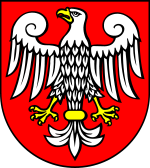
Magdeburg rights were a set of town privileges first developed by Otto I, Holy Roman Emperor (936–973) and based on the Flemish Law, which regulated the degree of internal autonomy within cities and villages granted by the local ruler. Named after the city of Magdeburg, these town charters were perhaps the most important set of medieval laws in Central Europe. They became the basis for the German town laws developed during many centuries in the Holy Roman Empire. The Magdeburg rights were adopted and adapted by numerous monarchs, including the rulers of Bohemia, Hungary, Poland, and Lithuania, a milestone in the urbanization of the region which prompted the development of thousands of villages and cities.

The coat of arms of Poznań consists of white city walls with three towers. On the left (heraldic) tower stands Saint Peter with a key and on the heraldic right one stands Saint Paul with a sword. In the gate there are two golden crossed keys with a cross above. Over the middle tower, which contains a single window and is topped by a battlement, there is a gothic shield with a white eagle in crown. On the sides of the two saints there are golden crescents and stars. All of those elements are on a blue field. Over the shield there is golden crown. Author of modern version of coat of arms is Jerzy Bąk.

The coat of arms that serves as the symbol of the Lublin Voivodeship, Poland depicts a white (silver) male jumping cervus (deer), with a yellow (golden) crown on its neck, placed on a red background. The current design of the coat of arms was designed by Andrzej Heidrich, and adopted in 2002.

Throughout most of the history of Poland, the banner of Poland was one of the main symbols of the Polish State, normally reserved for use by the head of state. Although its design changed with time, it was generally a heraldic banner, i.e., one based directly on the national coat of arms: a crowned White Eagle on a red field. The banner should not be confused with the flag of Poland, a white and red horizontal bicolor, officially adopted in 1919.

The coat of arms that serves as the official symbol of the Masovian Voivodeship, Poland, consists of a red escutcheon, that features a white (silver) eagle, with raised wings, and its head turned left. Its current version had been designed by Andrzej Heidrich, and adopted in 2006.

The coat of arms of the Lesser Poland Voivodeship, Poland features a white (silver) eagle with a yellow (golden) crown on his head that is turned left, a beak, legs, and a stripes on its wings, with the charge placed on the red background. It was designed by Wojciech Drelicharz, Zenon Piech, and Barbara Widłak, and adopted in 1999.

The coat of arms, that serves as the symbol of the Opole Voivodeship, Poland, features a yellow (golden) eagle wearing a yellow (golden) crown, placed on a blue background. It was adopted in 2001.
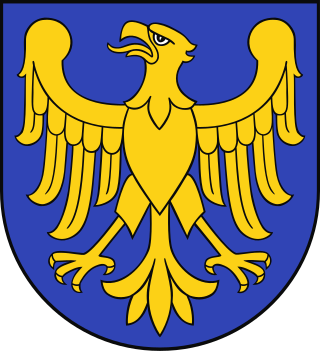
The coat of arms, that serves as the symbol of the Silesian Voivodeship, Poland, features a yellow (golden) eagle on a blue background. The current version of the coat of arms was adopted in 2001, and based on the historical coats of arms of Upper Silesia.

The flag of the Masovian Voivodeship, Poland is a red rectangle with silver (white) eagle, with golden (yellow) beak and legs, located on the left side of the flag.

The coat of arms of Lubusz Voivodeship, Poland, features an Iberian style escutcheon divided vertically onto two sides, of which, the left side has red background, with left side of a white (silver) eagle, with yellow (golden) crown, legs, a ring on its tail, and a przepaska on its wing, while the right side, has green background with two yellow (golden) six-pointed stars, placed vertically. It was established in 2000.

The coat of arms of the Łódź Voivodeship, Poland is an Iberian-style escutcheon with square top and rounded base. It is divided horizontally into three stripes (pales), that area from left to right: yellow (golden), red, and yellow (red), with the middle stripe being twice as big as the other stripes. It also include three charges placed in its center, with two placed next to each over, on the top of the third one. The top two charges are Kuyavian Hybrids, divided into half, into a lion and an eagle, while the bottom one is an eagle. It was designed by Marek Adamczewski, and officially adopted on 25 June 2002.
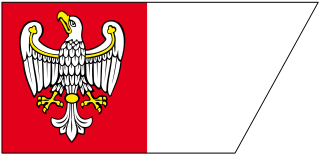
The flag of the Greater Poland Voivodeship, Poland is a trapezoid divided into red stripe on the right, and white stripe on the left, with a white eagle with yellow (golden) beak, legs, stripes on its wings, and a ring on its tail, featured in the middle of the red stripe. It was adopted in 2000.

The flag of the Świętokrzyskie Voivodeship, Poland is a rectangle divided into four parts. Its left part features a yellow vertical stripe, which wight equals to 1:4 of the wight of the flag. Its right part is divided into three horizontal stripes, that are, from top to bottom: blue, white, and red. In the middle of the white stripe is placed the coat of arms of the voivodeship. The first version of the flag had been adopted in 2001, and current version is used since 2013.
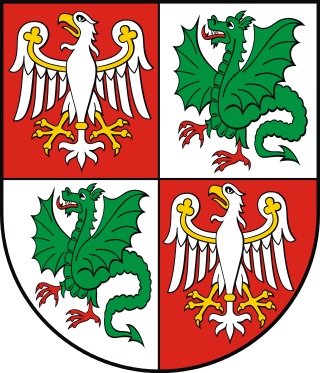
The coat of arms and the flag that serve as the symbols of the Warsaw West County, Masovian Voivodeship, in east-central Poland.

The coat of arms of the Kuyavian-Pomeranian Voivodeship, Poland, consists of a white (silver) escutcheon, with a half of an eagle facing left, joined with a half of a lion facing right, both animals together wearing a yellow (golden) crown on their joined heads. It had been adopted in 2000.
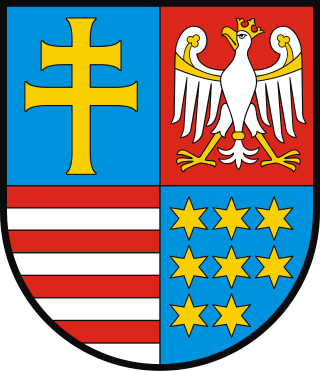
The coat of arms that serves as the symbol of the Świętokrzyskie Voivodeship, Poland, consists of the Iberian style escutcheon (shield), with square top and rounded base, that is divided in the 2 by 2 chessboard pattern. The top left field features a yellow patriarchal cross. The top right field features a white eagle with yellow crown, beak, legs, stripes on its wings, and a ring on its tail. The bottom left field features eight yellow six-pointed starts, placed in three rows, each with three stars, with the exception of the bottom row, that only had 2 stars, placed to the left.
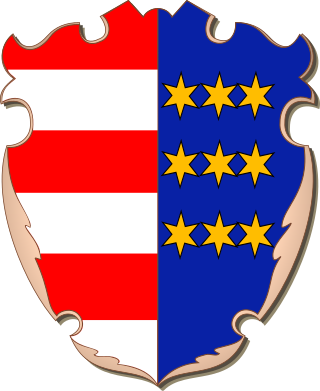
A historical coat of arms symbolized the Sandomierz Land and Sandomierz Voivodeship of the Kingdom of Poland from the 14th to 18th centuries. It was divided into two fields, with the left field consisting of six stripes, alternating either between red and white or red and yellow, and with the right field consisting of several yellow six-pointed stars, whose number varie dbetween seven and nine.

The coat of arms that serves as the symbol of Podlaskie Voivodeship, Poland is divided into two horizontal red fields. The top field depicts a white eagle, and a bottom field, a knight in a white (silver) armor, sitting on a white (silver) horse with a blue saddle and shabrack, and yellow (golden) harness, standing on its back hoofs. The knight has a blue shield with a yellow (golden) cross of Lorraine on it, put on his left arm, and hold a sword in his right hand. The current design of the coat of arms was designed by Tadeusz Gajl, and adopted in 2001.
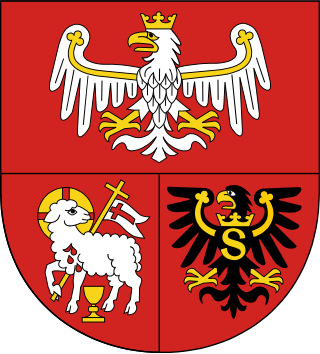
The coat of arms of the Warmian–Masurian Voivodeship, Poland consists of a red Iberian style escutcheon (shield) that is divided horizontally into two parts. The top part features a white eagle with a yellow (golden) crown on its head. The bottom part is divided vertically into two fields. The left bottom field depicting a Lamb of God, in a form of a white (silver) sheep with a yellow (golden) circular aureola behind its head, holding in its right hoof, a yellow (golden) cross with a white (silver) banner with red cross on it, attached to it, and bleeding from its chest, with the red drops of blood falling towards a yellow (golden) chalice placed in front of it, between its legs. The right bottom field depicts a black eagle with a yellow (golden) crown put on its neck, and a capital letter S placed on its chest.

The coat of arms of Pomerania, also known as the Pomeranian Griffin, is the symbol of Pomerania, a historical region on the southern shore of the Baltic Sea in Central Europe, split between Poland and Germany. It depicts a red griffin with yellow (golden) beak and claws, placed within a white (silver) shield. It originates from the late 12th century.


